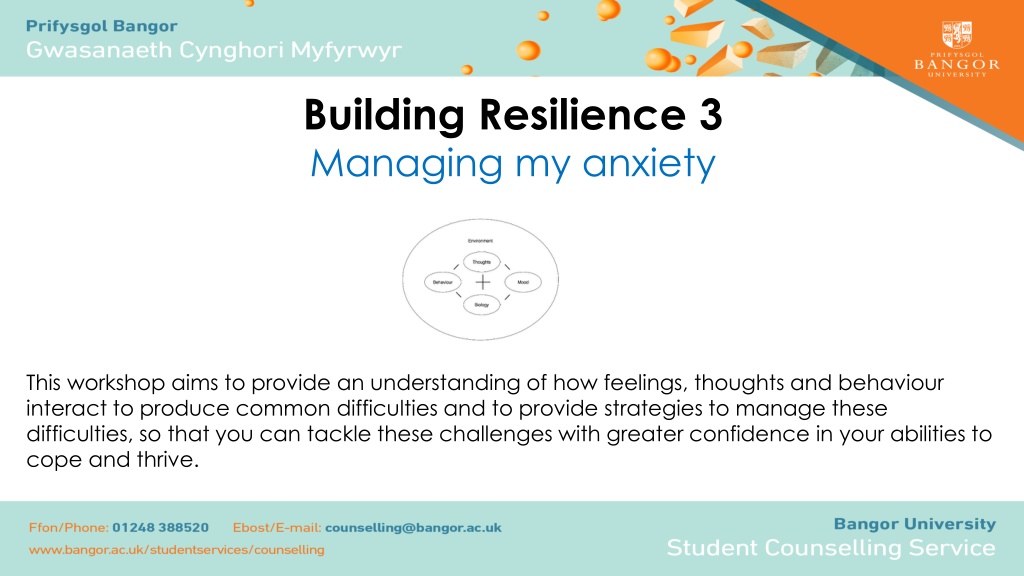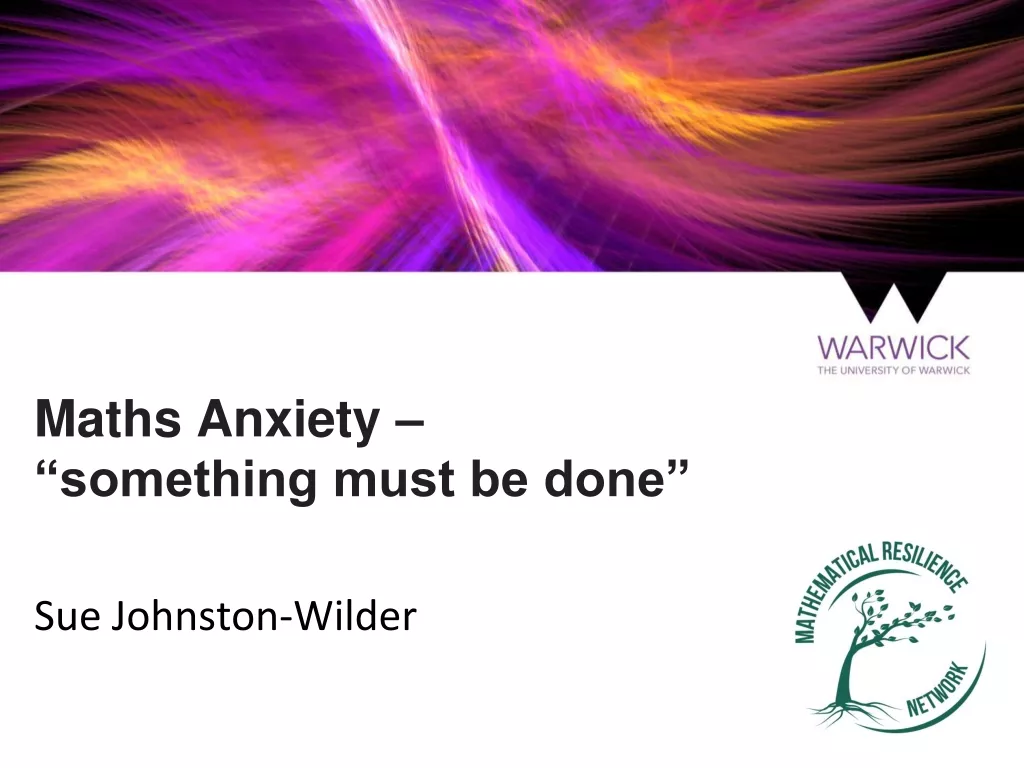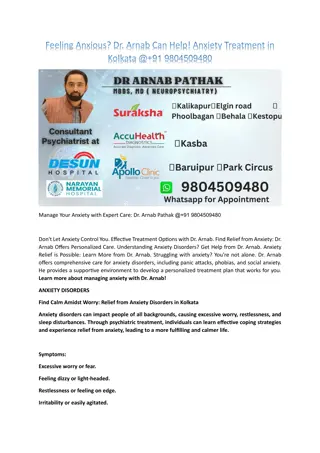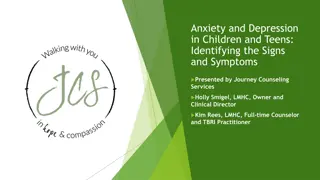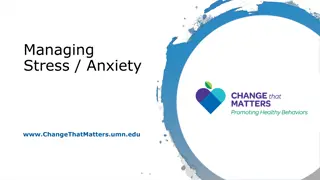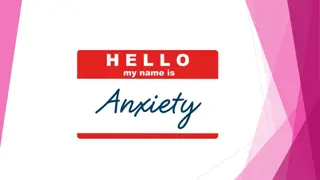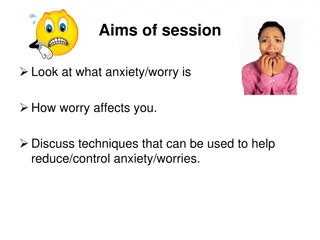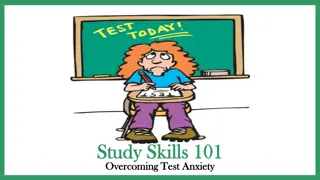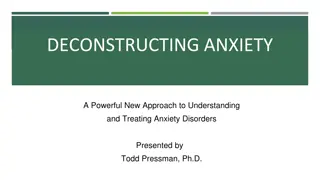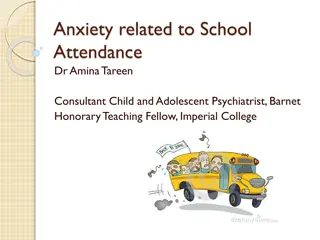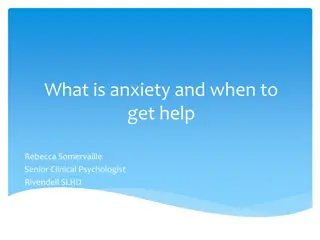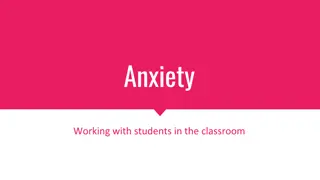Understanding and Managing Anxiety: Building Resilience Workshop
This workshop aims to provide an understanding of how feelings, thoughts, and behavior interact to produce common difficulties related to anxiety and offers strategies to manage these challenges effectively. By learning about anxiety, its symptoms, and when it becomes a problem, individuals can develop the confidence to cope and thrive in the face of anxiety-inducing situations.
Download Presentation

Please find below an Image/Link to download the presentation.
The content on the website is provided AS IS for your information and personal use only. It may not be sold, licensed, or shared on other websites without obtaining consent from the author. Download presentation by click this link. If you encounter any issues during the download, it is possible that the publisher has removed the file from their server.
E N D
Presentation Transcript
Building Resilience 3 Managing my anxiety This workshop aims to provide an understanding of how feelings, thoughts and behaviour interact to produce common difficulties and to provide strategies to manage these difficulties, so that you can tackle these challenges with greater confidence in your abilities to cope and thrive.
What is Anxiety? Anxiety is a word we use to describe feelings of unease, worry and fear. It incorporates both the emotions and the physical sensations we might experience when we are worried or nervous about something. Although we usually find it unpleasant, anxiety is related to the fight or flight response our normal biological reaction to feeling threatened. From mind.org.uk
When is anxiety a problem? Feelings of anxiety are a normal response to life challenges- e.g. before a job interview; a group presentation; or an exam. But anxiety becomes a problem when; Anxious feelings are overwhelming and affect performance negatively. Anxiety is so strong it stops us doing things we need to do. Anxiety is so strong we begin having panic attacks. Anxiety is not short lived but becomes long lasting, entrenched and pervades many aspects of our lives. We find that we re worrying all the time, perhaps about things that are a normal part of everyday life, or about things that may not happen or even worrying about worrying.
Why Learn about anxiety? Many people don t understand anxiety and think that: there s something wrong physically they are going crazy they are weird These thoughts only make them more anxious Understanding the nature of anxiety and how it works is the first step in learning to manage it.
Learning the facts about anxiety Anxiety is normal - we all get anxious. Anxiety is adaptive - it helps us deal with REAL danger. Without an effective threat detection system our species would not have survived. Anxiety is not dangerous- its unpleasant but not harmful-its there to help you. Anxiety does not last forever - it eventually passes. Most people can t tell you are feeling anxious.
Anxiety Symptoms: What happens in your body Rapid heartrate- heart thumping Rapid Breathing Sweating Nausea and stomach upset Feeling dizzy or light-headed Tight/painful chest Numbness or tingling sensations Unreality/bright vision Heavy legs Choking sensations Hot and cold flushes Need to go to the toilet
Anxiety symptoms: What happens in your mind? In your emotions you may feel tense, nervous and on edge a sense of dread, or fearing the worst restless or agitated scared or panicky Your mind is busy whirring with repetitive thought patterns. is prone to dwell on negative experiences, thinking situations over and over again. has difficulty concentrating, thinking clearly or focusing effectively. has difficulty remembering things. has difficulty making decisions.
Anxiety Symptoms: What changes might happen in your behaviour? Poor sleep Loss of appetite or over-eating Decline in academic performance Increase in substance use Withdrawal from friends and activities Lowered sex drive Loss of enjoyment and pleasure AVOIDANCE
Trigger Fight/Flight/ Freeze Thoughts Behaviour Feelings Sensations Adrenaline Cortisol How does anxiety work?
Thoughts Trigger Fight/Flight/ Freeze Flying-engine makes strange noise Plane might crash, might die, funeral Feelings Behaviour Scared, worried, sad Never fly again Sensations Adrenaline Cortisol Example: Fear of Flying Breathless, sweaty, heart pounding
Trigger Fight/Flight/ Freeze Thoughts Behaviour Feelings Sensations Adrenaline Cortisol Can you think of an example of your own?
Some features of anxiety: Anxiety is stone age software in 21stcentury life. Adrenaline and Cortisol is not used up so remain in our bodies making us feel uncomfortable. My life has been full of disasters, most of which have never happened . Montaigne. Anxiety is helpful when danger is real but is a problem when there s no real danger as in an over-sensitive smoke alarm. Body s alarm system can t distinguish between imagined and real dangers. Much anxiety is thought driven. Anxiety often leads to escalating vicious circles. Anxiety commonly leads to avoidance which makes the problem bigger. We don t learn that we can cope.
Thoughts Trigger Fight/Flight/ Freeze Thoughts about sensation Feelings Behaviour Adrenaline Cortisol Sensations Escalating vicious circles leads to Panic Attacks
Quick techniques for Managing Panic 1. Stop Technique When you notice panic building say STOP to yourself - out loud if the situation permits this. Breathe in gently. Breathe out slowly, relaxing SHOULDERS, ARMS and HANDS. Pause. Breathe in again. Breathe out slowly relaxing FOREHEAD and JAW. Pause then carry on with what you were doing, moving a little more slowly, talking more slowly, with your voice a little lower. 2. Anti-anxiety breathing - short in breath/ long out breath. COUNT.
Strategies for Managing Anxiety- Learn Mindfulness skills. Learn to think realistically. Learn to confront the situations you avoid in small steps; graded exposure. Adopt an anti-anxiety lifestyle.
Mindfulness Approaches Mindfulness is developed by purposefully paying attention in a non-judgmental way to your experience of your body, your mind and the world around you. Mindfulness is about being awake and aware and living in the present, rather than dwelling in the past or anticipating the future. Staying in touch with the present in this way, from one moment to the next, may lead you to experience yourself differently, perhaps feeling less stuck, or recognizing more strength, balance and confidence in yourself. Mindfulness is taught through meditation skills which include bringing attention to the breath and the body during stillness and movement.
How can Mindfulness help with anxiety? Learning mindfulness gives us the skills to: learn to ground ourselves enabling thinking to come back online; pay attention to our thoughts; label anxious thinking when we notice it; take a step back mentally and let the thinking go-like a cloud in the sky or water flowing; stop ourselves getting involved in the thinking; use our breath and body to ground us in the present; distract ourselves when necessary.
Learning Mindfulness Skills Learning Mindfulness skills takes time, commitment and perseverance - like learning any new skill. You can learn by Attending the Mindfulness Drop-in o every Tuesdays 11am-11:50am in term time at Rathbone Annexe. Using free apps, such as Insight Timer.
What is realistic thinking? Realistic thinking involves noticing and letting go of our tendency to go with our automatic knee-jerk reactions to a situation. It involves slowing down and considering all aspects of a situation - positive, negative and neutral, before reaching a conclusion or decision about a course of action. It means looking at yourself, others and the world in a fair and balanced way.
How to develop realistic thinking skills 1. Pay attention to the way you talk to yourself. (Learning Mindfulness skills can help us to notice this more readily) 2. Identify thoughts that lead to feelings of anxiety. Ask yourself: What am I thinking right now? What is making me feel anxious? What am I worried will happen? What bad thing do I expect to happen?
3. Challenge your anxious thinking Thinking something doesn t make it true. Look out for thinking traps: Fortune telling Black and white thinking Mind-reading Over-generalisation Labelling Over-estimating danger Catastrophising Shoulds and Musts Filtering
4.Look at the evidence and formulate a new, balanced thought. Q. What evidence do I have for this thought? What evidence do I have against? Put your thought on trial Use thought record to do this
Thought Record: Situation. Feeling Now- (0-10) Anxious thoughts. Evidence For/Against thoughts. Feeling After. For Against: Hot thought Balanced Thought- Try a thought record yourself
Facing your fears; graded exposure: How to do it 1. Make a list of all the things you avoid because they are too scary. Then rewrite your list with the scariest at the top and the least scariest at the bottom. 2. Then choose one of the items at the bottom of your list to focus on. Draw a ladder with lots of rungs. Work out what you want to achieve with this item and put it on the top of the ladder. Then break down how you will get there into SMALL STEPS. Be imaginative. 3. Then Beginning with Step 1 - the easiest step, do it over and over again until it no longer creates any anxiety. The more you do it the easier it will get. Once you can do this move on to Step 2 and so on. Exposure needs to be PLANNED, PROLONGED and REPEATED.
Example of graded exposure for presentation anxiety: Aim: Be able to deliver the presentation confidently and well 7. Practice giving it to a few friends in the room 6. Practice reading it out loud to myself in the room 5. Familiarise myself with the room where the session will be held 4. Practice by giving it to a few friends and asking for feedback 3. Practice by giving it to a few friends in my room 2. Practice by giving it to a friend in my room 1. Practice by giving my presentation aloud to myself in my room
Step 4: Keep Practising. Maintain the gains you have made. Step 5: Reward brave behaviour. Facing fears is not easy, so reward yourself when you achieve a goal. Don t be discouraged if fears creep back in times of stress - just use the tools you have learnt to get started again. Coping with anxiety is a lifelong task.
Anti-Anxiety lifestyle Eat well Develop a good sleeping pattern Cultivate hobbies and have fun with friends Regular physical exercise will burn off anxiety hormones Be careful about caffeine, alcohol, smoking and drugs Learn relaxation skills- or Mindfulness, Yoga, Tai Chi etc Work towards having a balanced life
Resources available: Use support systems available within the University - Academic support-personal tutors, subject tutors, Dyslexia Service, Study Support Service Student Support - Disability Services, Money Support. Student Union Services. Learn more about anxiety and ways to overcome it. Attend Building Resilience workshops - see Counselling Service website. Learn Mindfulness Meditation. Look at self help links on Counselling Service website. This Workshop attracts BEA points.
And Finally. Theres a Hole in my Sidewalk An Autobiography in Five Short Chapters (Nelson, 1994) I) I walk down the street. There is a deep hole in the sidewalk. I fall in. I am lost ... I am helpless. It isn't my fault. It takes me forever to find a way out. 3) I walk down the same street. There is a deep hole in the sidewalk. I see it is there. I still fall in ... it's a habit. My eyes are open. I know where I am. It is my fault. I get out immediately. 2) I walk down the same street. There is a deep hole in the sidewalk. I pretend I don't see it. I fall in again. I can't believe I am in the same place. But, it isn't my fault. It still takes a long time to get out. 4) I walk down the same street. There is a deep hole in the sidewalk. I walk around it. 5) I walk down another street.
